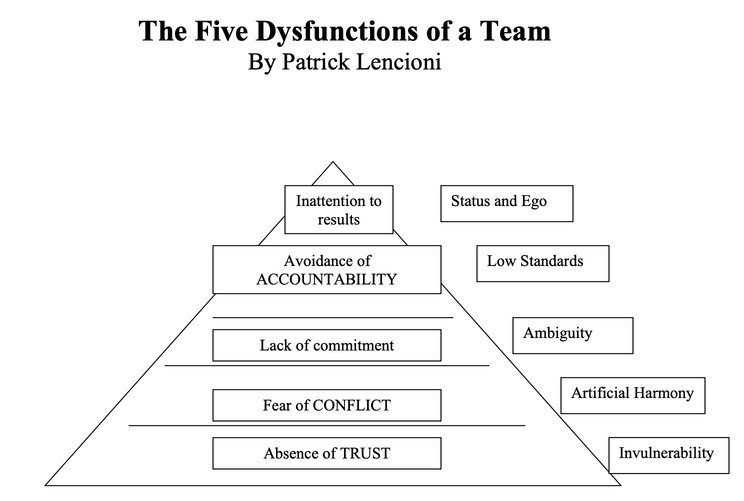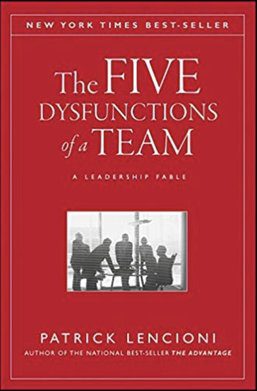“A fractured team is just like a broken arm or leg; fixing it is always painful, and sometimes you have to rebreak it to make it heal correctly. And the rebreak hurts a lot more than the initial break, because you have to do it on purpose.”
Print | Kindle (eBook) | Audiobook
The Five Dysfunctions of a Team book explores the fundamental causes of organizational politics, cohesion, and team failure. The book details many pitfalls that teams face as they seek to “grow together.”
According to the book, organizations fail to achieve teamwork because they unknowingly fall prey to five natural but dangerous pitfalls, called the Five Dysfunctions:

Dysfunction 1: Absence of trust—unwilling to be vulnerable within the group
The first dysfunction is an absence of trust among team members. Essentially, this stems from their unwillingness to be vulnerable within the group. Team members who are not genuinely open with one another about their mistakes and weaknesses make it impossible to build a foundation for trust.
Dysfunction 2: Fear of conflict—seeking artificial harmony over constructive passionate debate
This failure to build trust is damaging because it set the tone for the second dysfunction: fear of conflict. Teams that lack trust are incapable of engaging in unfiltered and passionate debate of ideas. Instead, they resort to veiled discussions and guarded comments.
Dysfunction 3: Lack of commitment—feigning buy-in for group decisions creates ambiguity throughout the organization
A lack of healthy conflict is a problem because it ensures the third dysfunction of a team: lack of commitment. Without having aired their opinions in the course of passionate and open debate, team members rarely, if ever, buy in and commit to decisions, though they may feign agreement during meetings.
Dysfunction 4: Avoidance of accountability—ducking the responsibility to call peers on counterproductive behavior which sets low standards
Because of this lack of real commitment and buy-in, team members develop an avoidance of accountability, the fourth dysfunction. Without committing to a clear plan of action, even the most focused and driven people often hesitate to call their peers on actions and behaviors that seem counterproductive to the good of the team.
Dysfunction 5: Inattention to results—focusing on personal success, status and ego before team success
Failure to hold one another accountable creates an environment where the fifth dysfunction can thrive. Inattention to results occurs when team members put their individual needs (such as ego, career development, or recognition) or even the needs of their divisions above the collective goals of the team.
Here are the strategies recommended for dealing with the Five Dysfunctions of a team:
Dealing with Absence of Trust
Members of teams with an absence of trust . . .
• Conceal their weaknesses and mistakes from one another
• Hesitate to ask for help or provide constructive feedback
• Hesitate to offer help outside their own areas of responsibility
• Jump to conclusions about the intentions and aptitudes of others
without attempting to clarify them
• Fail to recognize and tap into one another’s skills and experiences
• Waste time and energy managing their behaviors for effect
• Hold grudges
• Dread meetings and find reasons to avoid spending time together
Members of trusting teams . . .
• Admit weaknesses and mistakes
• Ask for help
• Accept questions and input about their areas of responsibility
• Give one another the benefit of the doubt before arriving at a negative conclusion
• Take risks in offering feedback and assistance
• Appreciate and tap into one another’s skills and experiences
• Focus time and energy on important issues, not politics
• Offer and accept apologies without hesitation
• Look forward to meetings and other opportunities to work as a group
Strategies to Building a Trusting Team:
Personal Histories Exercise
In less than an hour, a team can take the first steps toward developing trust. This low risk exercise requires nothing more than going around the table during a meeting and having team members answer a short list of questions about themselves.
Questions need not be overly sensitive in nature and might include the following: number of siblings, hometown, unique challenges of childhood, favorite hobbies, first job, and worst job.
Simply by describing these relatively innocuous attributes or experiences, team members begin to relate to one another on a more personal basis, and see one another as human beings with life stories and interesting backgrounds.
Goal: This encourages greater empathy and understanding, and discourages unfair and inaccurate behavioral attributions.
Team Effectiveness Exercise
It requires team members to identify the single most important contribution that each of their peers makes to the team, as well as the one area that they must either improve upon or eliminate for the good of the team. All members then report their responses, focusing on one person at a time, usually beginning with the team leader.
Personality and Behavioral Preference Profiles
Profile team members’ behavioral preferences and personality styles. These help break down barriers by allowing people to better understand and empathize with one another.
Recommended: Myers-Briggs Type Indicator (MBTI).
Goal: The purpose of most of these tools is to provide practical and scientifically valid behavioral descriptions of various team members according to the diverse ways that they think, speak, and act.
360-Degree Feedback
Calls for peers to make specific judgments and provide one another with constructive criticism.
The Role of the Leader in Building Trust
The most important action that a leader must take to encourage the building of trust on a team is to demonstrate vulnerability first. This requires that a leader risk losing face in front of the team, so that subordinates will take the same risk themselves.
Dealing with Fear of Conflict:
Teams that fear conflict . . .
• Have boring meetings
• Create environments where back-channel politics and personal attacks thrive
• Ignore controversial topics that are critical to team success
• Fail to tap into all the opinions and perspectives of team members
• Waste time and energy with posturing and interpersonal risk management
Teams that engage in conflict . . .
• Have lively, interesting meetings
• Extract and exploit the ideas of all team members
• Solve real problems quickly
• Minimize politics
• Put critical topics on the table for discussion
Strategies for making conflict more common and productive.
Mining
Members of teams that tend to avoid conflict must occasionally assume the role of a “miner of conflict”— someone who extracts buried disagreements within the team and sheds the light of day on them. They must have the courage and confidence to call out sensitive issues and force team members to work through them.
Real-Time Permission
In the process of mining for conflict, team members need to coach one another not to retreat from healthy debate. One simple but effective way to do this is to recognize when the people engaged in conflict are becoming uncomfortable with the level of discord, and then interrupt to remind them that what they are doing is necessary.
Thomas-Kilmann Conflict Mode Instrument
The Thomas–Kilmann Conflict Mode Instrument (TKI) is a conflict style inventory, which is a tool developed to measure an individual’s response to conflict situations.
It allows team members to understand natural inclinations around conflict so they can make more strategic choices about which approaches are most appropriate in different situations.
The Role of a Leader in Encouraging productive Conflict
it is key that leaders demonstrate restraint when their people engage in conflict, and allow resolution to occur naturally, as messy as it can sometimes be. This can be a challenge because many leaders feel that they are somehow failing in their jobs by losing control of their teams during conflict.
Dealing with DYSFUNCTION 3: LACK OF COMMITMENT
The two greatest causes of the lack of commitment are the desire for consensus and the need for certainty.
A team that fails to commit . . .
• Creates ambiguity among the team about direction and priorities
• Watches windows of opportunity close due to excessive analysis and unnecessary delay
• Breeds lack of confidence and fear of failure
• Revisits discussions and decisions again and again
• Encourages second-guessing among team members
A team that commits . . .
• Creates clarity around direction and priorities
• Aligns the entire team around common objectives
• Develops an ability to learn from mistakes
• Takes advantage of opportunities before competitors do
• Moves forward without hesitation
• Changes direction without hesitation or guilt
Strategies to encourage Commitment:
Cascading Messaging
At the end of a staff meeting or off-site, a team should explicitly review the key decisions made during the meeting, and agree on what needs to be communicated to employees or other constituencies about those decisions.
What often happens during this exercise is that members of the team learn that they are not all on the same page about what has been agreed upon and that they need to clarify specific outcomes before putting them into action.
Deadlines
As simple as it seems, one of the best tools for ensuring commitment is the use of clear deadlines for when decisions will be made, and honoring those dates with discipline and rigidity. The worst enemy of a team that is susceptible to this dysfunction is ambiguity, and timing is one of the most critical factors that must be made clear.
Contingency and Worst-Case Scenario Analysis
A team that struggles with commitment can begin overcoming this tendency by briefly discussing contingency plans up front or, better yet, clarifying the worst-case scenario for a decision they are struggling to make. This usually allows them to reduce their fears by helping them realize that the costs of an incorrect decision are survivable, and far less damaging than they had imagined.
Low-Risk Exposure Therapy
Another relevant exercise for a commitment-phobic team is the demonstration of decisiveness in relatively low-risk situations. When teams force themselves to make decisions after substantial discussion but little analysis or research, they usually come to realize that the quality of the decision they made was better than they had expected.
The Role of the Leader in encouraging Commitment
More than any other member of the team, the leader must be comfortable with the prospect of making a decision that ultimately turns out to be wrong. And the leader must be constantly pushing the group for closure around issues, as well as adherence to schedules that the team has set.
DYSFUNCTION 4: AVOIDANCE OF ACCOUNTABILITY
A team that avoids accountability . . .
• Creates resentment among team members who have different standards of performance
• Encourages mediocrity
• Misses deadlines and key deliverables
• Places an undue burden on the team leader as the sole source of discipline
A team that holds one another accountable . . .
• Ensures that poor performers feel pressure to improve
• Identifies potential problems quickly by questioning one another’s approaches without hesitation
• Establishes respect among team members who are held to the same high standards
• Avoids excessive bureaucracy around performance management and corrective action
Suggestions for Overcoming Dysfunction 4
Publication of Goals and Standards
A good way to make it easier for team members to hold one another accountable is to clarify publicly exactly what the team needs to achieve, who needs to deliver what, and how everyone must behave in order to succeed.
Simple and Regular Progress Reviews
A little structure goes a long way toward helping people take action that they might not otherwise be inclined to do.
Team members should regularly communicate with one another, either verbally or in written form, about how they feel their teammates are doing against stated objectives and standards.
Team Rewards
By shifting rewards away from individual performance to team achievement, the team can create a culture of accountability. This occurs because a team is unlikely to stand by quietly and fail because a peer is not pulling his or her weight.
Role of the Leader in creating Accountability
Once a leader has created a culture of accountability on a team, however, he or she must be willing to serve as the ultimate arbiter of discipline when the team itself fails.
DYSFUNCTION 5: INATTENTION TO RESULTS
A team that is not focused on results . . .
• Stagnates/fails to grow
• Rarely defeats competitors
• Loses achievement-oriented employees
• Encourages team members to focus on their own careers and individual goals
• Is easily distracted
A team that focuses on collective results . . .
• Retains achievement-oriented employees
• Minimizes individualistic behavior
• Enjoys success and suffers failure acutely
• Benefits from individuals who subjugate their own goals/interests for the good of the team
• Avoids distractions
Strategies to enable a team focus on collective results
Public Declaration of Results
Teams that are willing to commit publicly to specific results are more likely to work with a passionate, even desperate desire to achieve those results. Teams that say, “We’ll do our best,” are subtly, if not purposefully, preparing themselves for failure.
Results-Based Rewards
An effective way to ensure that team members focus their attention on results is to tie their rewards, especially compensation, to the achievement of specific outcomes.
This approach is a little bit trick as it might lead to team members resulting in questionable actions to get the result – Check out :
Wells Fargo account fraud scandal
Ethical Fading as explained in The Infinite Game by Simon Sinek
Role of the Leader in encouraging Result
Team leaders must be selfless and objective, and reserve rewards and recognition for those who make real contributions to the achievement of group goals.
I found the Five Dysfunctions of a team very insightful and enlightening, lots of great concepts on Leadership and Teambuilding.
All the best in your quest to get better, Don’t Settle: Live with Passion.



1 Comment
Pingback: 100 Books Reading Challenge 2020 – Lanre Dahunsi